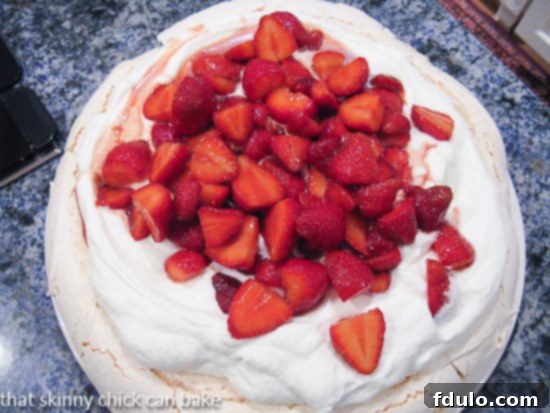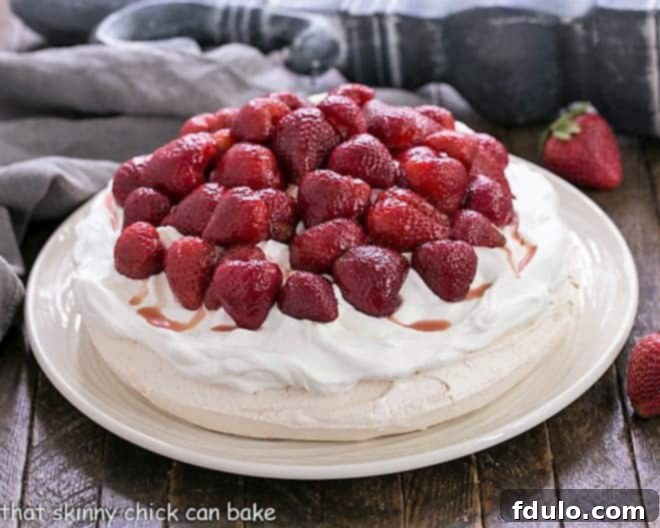Experience the ultimate summer delight with this spectacular Strawberry Pavlova recipe! Featuring a gloriously crisp yet “squidgy” meringue base, crowned with a generous cloud of whipped cream, and adorned with sweet-tart balsamic strawberries, this dessert is a true showstopper. It’s perfect for any occasion that calls for an elegant yet easy-to-make treat.
Pavlova recipes are a fantastic choice for warm-weather gatherings, holidays, or simply whenever you can find the freshest, most fragrant berries. Crafted from readily available ingredients, a homemade pavlova dessert consistently garners “oohs” and “aahs” from guests. Its light, airy texture and vibrant fresh fruit make it an irresistible centrepiece for any table. Dive into the delightful world of meringues and discover why this classic dessert has charmed taste buds for generations.

Why This Strawberry Pavlova Shines
Among the myriad of delightful desserts, the Strawberry Pavlova stands out as a truly exceptional creation, offering a perfect blend of texture, flavour, and visual appeal. This particular recipe ensures a successful and unforgettable experience, making it a must-try for both novice and experienced bakers. Here’s why you absolutely must make this stunning dessert:
- A Touch of Nostalgia: For many, desserts involving a meringue base evoke fond memories. This recipe builds on that timeless appeal, reminiscent of luscious creations like lemon curd-topped meringues, introducing a new generation to the joy of pavlova. It’s a dessert that feels both classic and refreshingly modern.
- Inspired by Acclaim: This recipe draws inspiration from highly praised versions, like Nigella Lawson’s renowned chocolate pavlova adorned with vibrant raspberries and cream. Such culinary inspirations provide a solid foundation, ensuring a tested and loved outcome. You can trust that the principles applied here lead to a dessert celebrated by many.
- Guaranteed Crowd-Pleaser: There’s nothing more satisfying than serving a dessert that vanishes in an instant. This pavlova has a proven track record of being an absolute sensation at gatherings. Its impressive appearance and delightful taste make it a memorable addition to any event, often warranting a second batch to satisfy eager family members!
- Effortlessly Elegant: While the Strawberry Pavlova looks incredibly sophisticated, its preparation is surprisingly straightforward. The beauty lies in its natural, rustic charm, which means you don’t need to be a professional pastry chef to achieve stunning results. The contrast of the crisp meringue, soft cream, and juicy strawberries creates a visual feast that’s as delightful to look at as it is to eat.
- Seasonal Perfection: This pavlova truly shines when made with peak-season strawberries. The recipe highlights the natural sweetness and slight tartness of fresh berries, creating a refreshing balance against the sweet meringue and rich cream. It’s the quintessential summer dessert, but can be enjoyed year-round with quality berries.

Essential Ingredients for Your Pavlova: What You Need to Know
Creating the perfect Strawberry Pavlova hinges on using high-quality ingredients and understanding their specific roles. Here’s a detailed look at each component and vital tips for selection and preparation:
- Egg Whites: These are the star of your meringue. Absolute purity is crucial; even the tiniest speck of egg yolk (which contains fat) will prevent the whites from whipping into stiff, stable peaks. Ensure your mixing bowl and beaters are impeccably clean and free of any grease or oil. Cold eggs are easier to separate, but room temperature egg whites whip to a higher volume more quickly. Plan ahead by separating eggs when cold, then allowing the whites to come to room temperature before beating.
- White Sugar, Superfine (Caster Sugar): While regular granulated sugar can be used, superfine sugar is highly recommended for pavlova. Its finer crystals dissolve more easily into the egg whites, resulting in a smoother, more stable, and less grainy meringue. This helps achieve that signature crisp exterior and marshmallowy interior. Look for brands like Domino’s superfine sugar, often found near standard granulated sugar.
- Table Salt: Just a pinch of salt. Even in sweet applications, salt enhances and balances flavours, preventing the dessert from being overwhelmingly sweet. It can also help stabilize the egg whites slightly.
- Cornstarch: This secret ingredient is key to the pavlova’s unique texture. Cornstarch helps to stabilize the meringue during baking and cooling, contributing to its signature “squidgy” (soft, marshmallow-like) interior while maintaining a crisp outer shell. It essentially acts as an anti-shrinkage agent.
-
Vinegar (White Wine or Champagne for Pavlova; Aged Balsamic for Strawberries):
- White wine or champagne vinegar for the pavlova: A small amount of acid, like vinegar or lemon juice, helps create a more stable meringue. It assists in denaturing the egg proteins, allowing them to whip up higher and creating a more tender interior.
- Good aged balsamic vinegar for the strawberries: This might sound unusual, but a high-quality balsamic vinegar adds a delightful complexity and depth to the strawberries. It enhances their natural sweetness and introduces a subtle, sophisticated tang that elevates the fruit topping beyond plain sliced berries.
- Real Vanilla Extract: Always choose pure vanilla extract over artificial vanilla flavouring. Real vanilla provides a much richer, more nuanced aroma and taste that significantly impacts the overall flavour profile of your dessert. Brands like Nielsen-Massey are renowned for their quality and are often a go-to for serious bakers.
- Fresh, Ripe Strawberries: The quality of your fruit directly impacts the success of your topping. Select strawberries that are vibrant red, glossy, and free from bruises or soft spots. Most importantly, choose fragrant berries, as they will undoubtedly offer the best flavour. Wash and hull them gently before halving or quartering, depending on their size.
- Heavy Whipping Cream: To achieve a luscious, stable whipped cream topping, use heavy whipping cream with at least 36% butterfat content. This higher fat content ensures the cream whips up thick and holds its shape well, providing a perfect, billowy contrast to the meringue. Ensure the cream is well-chilled before whipping for optimal results.
By paying close attention to these ingredients and preparation tips, you’re well on your way to crafting a truly magnificent Strawberry Pavlova that delights all the senses.

Step-by-Step Guide to Making Your Strawberry Pavlova
Creating this magnificent Strawberry Pavlova is a rewarding process, and following these detailed steps will ensure a perfect outcome. Get ready to impress with your culinary skills!
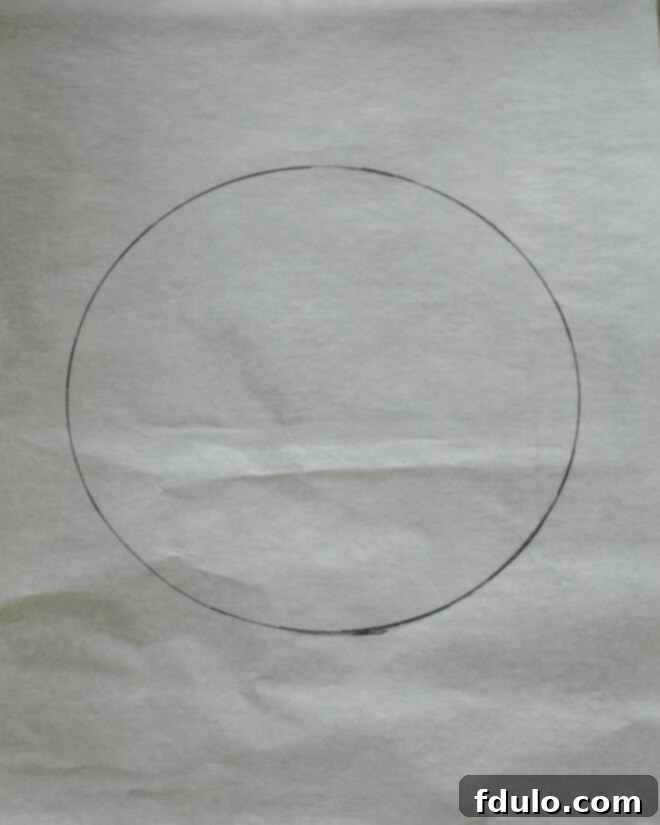
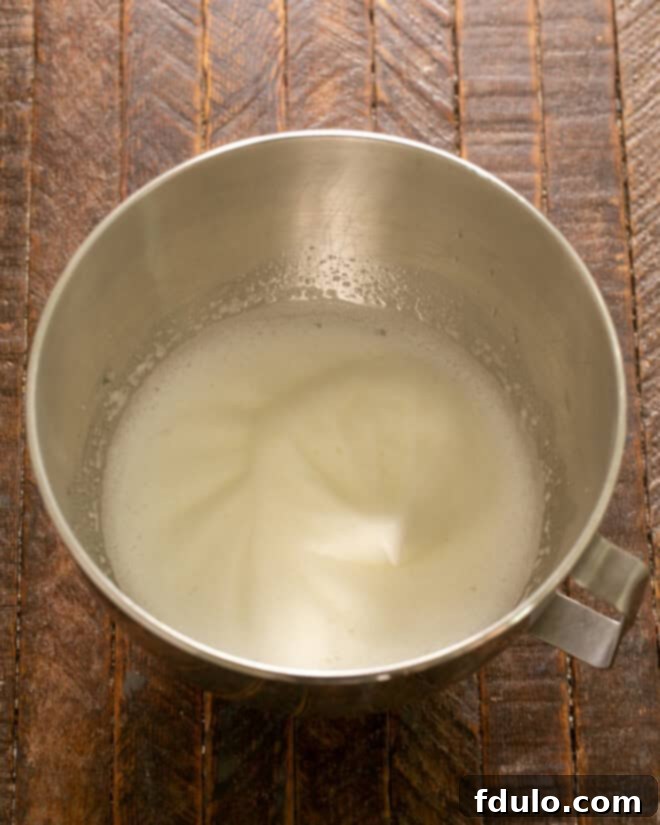


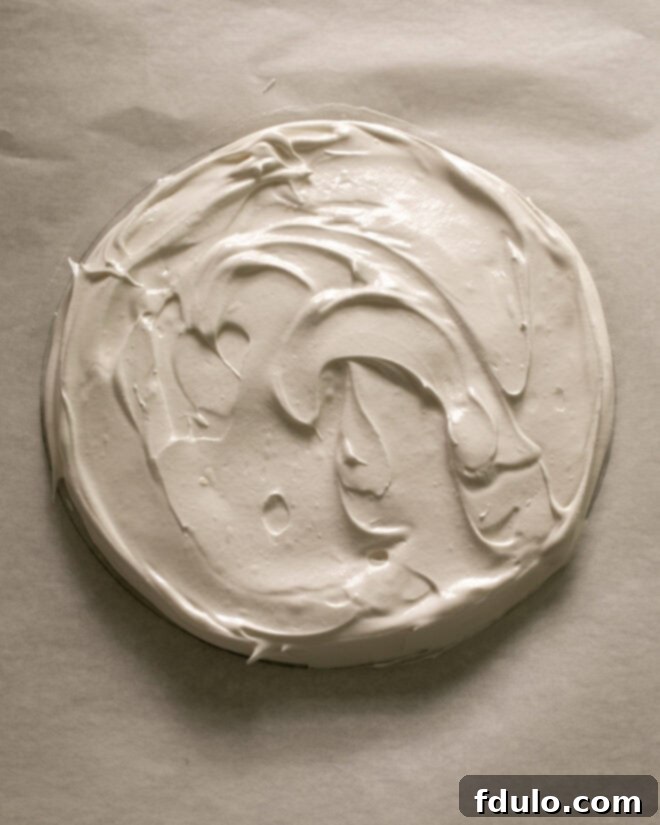




Expert Tips for Pavlova Perfection
Achieving a perfect Pavlova, with its crisp exterior and soft, marshmallowy interior, is an art form that’s easily mastered with a few key insights. Much like preparing delicate meringue cookies, there are specific techniques and considerations that ensure success. Here are some expert tips to guide you:
- PRO-Tip: The Immaculate Bowl & Beaters: This is perhaps the most critical rule for meringue. Any trace of grease or oil on your mixing bowl or beaters will prevent the egg whites from whipping up properly. They simply won’t reach their full volume or stability. To guarantee a grease-free environment, run all equipment through a hot dishwasher cycle or wash thoroughly with hot, soapy water, then dry completely. Some bakers even wipe their bowls with a lemon wedge to ensure maximum cleanliness.
- Separating Eggs with Care: When separating egg whites from yolks, extreme caution is necessary. Even a tiny speck of yolk, which contains fat, will contaminate the whites and hinder their ability to whip. It’s always best to separate each egg into a small, separate bowl before adding it to your main batch of whites. This way, if one yolk breaks, you only lose one white, not the entire batch. Contaminated whites must be discarded or saved for another use (like scrambled eggs), as they won’t work for pavlova.
- PRO-Tip: Temperature Matters for Egg Whites: Eggs separate most easily when they are cold, as the yolks are firmer. However, egg whites achieve the best volume and stability when whipped at room temperature. Plan ahead by separating your eggs when they’re cold, then let the egg whites sit on the counter for 30-60 minutes to warm up. If you’re short on time, you can carefully place the bowl of egg whites into a larger bowl of very warm (but not boiling, as you don’t want to cook them) water for 10-15 minutes to quickly bring them to temperature.
- PRO-Tip: Drawing Your Meringue Guide: For a perfectly shaped pavlova, always use parchment paper on your baking sheet. Trace an 8 or 9-inch circle on the parchment using a cake pan or a plate as a template. Crucially, once you’ve drawn the circle, flip the parchment paper over so the pencil or pen marks are on the underside. This prevents any potentially toxic lead or ink from transferring to your meringue while baking. Use the faint circle as a guide for spreading your beaten egg whites.
- The Low and Slow Bake: Pavlova requires a gentle, extended baking process at a lower-than-average temperature. This slow bake allows the meringue to dry out and crisp up without browning too quickly. The most important step after baking is to leave the pavlova in the oven as it cools down completely with the heat turned off. This gradual cooling process helps to further dry the meringue, prevent cracking, and develop that iconic crisp exterior with a soft, marshmallowy, slightly “squidgy” interior. Resist the urge to open the oven door during this cooling phase.
- Timing the Toppings: While the meringue base can be made ahead, it’s best to add the whipped cream and fruit toppings shortly before serving. The moisture from the cream and fruit will gradually soften the meringue shell over time. While a slightly softened meringue is still delicious, the preferred texture is when it’s freshly topped – with a delightful contrast between the crisp shell and the creamy, juicy toppings.
- Humidity is the Enemy: Meringues are highly susceptible to humidity. A humid environment can make your pavlova sticky, chewy, or even collapse. Try to bake pavlova on a dry day if possible. Once baked and cooled, store the meringue base in an airtight container at room temperature if not topping immediately. Avoid the refrigerator until toppings are added, as the fridge can introduce too much moisture.
By incorporating these expert tips into your process, you’ll master the art of making a flawless, mouth-watering Strawberry Pavlova every single time!
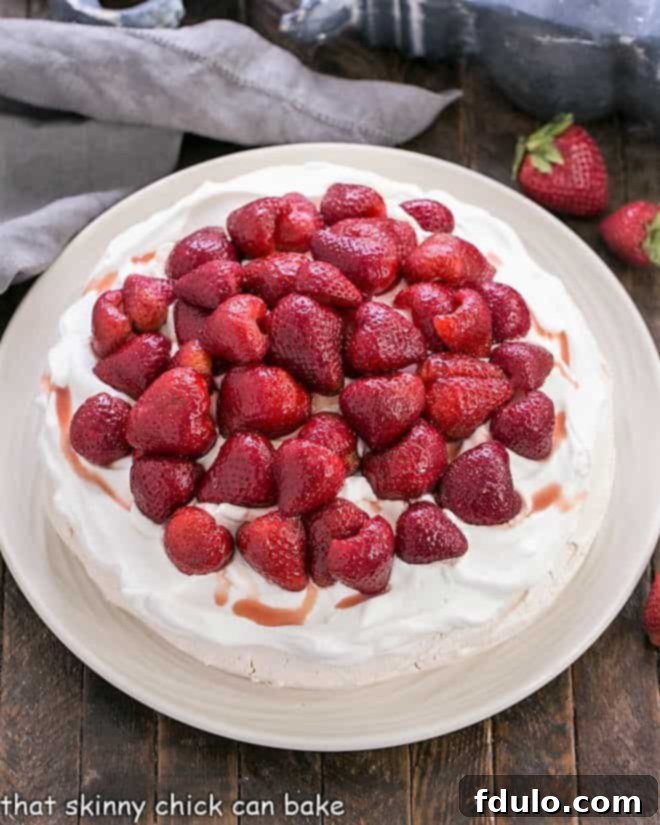
Frequently Asked Questions About Strawberry Pavlova
A Pavlova is an iconic meringue-based dessert, often described as a giant, cloud-like egg white cookie. According to the Food Lover’s Companion, a pavlova typically consists of “a crisp meringue base topped with whipped cream and fruit such as strawberries, passion fruit, and kiwi.” It’s renowned for its delicate, crunchy exterior and soft, marshmallowy interior. The origin of the pavlova is a subject of friendly debate between Australia and New Zealand, both claiming its invention. However, it is widely agreed that this elegant dessert was named in honour of the legendary Russian ballerina, Anna Pavlova, following her tour of both countries in 1926.
Proper storage is key to maintaining the integrity of your Pavlova. The baked meringue base can be prepared in advance and stored in an airtight container at room temperature. This protects it from humidity, which is the meringue’s worst enemy and can cause it to soften. A cool, dry place like an oven (when it’s off, of course!) makes a terrific spot for storing a bare pavlova shell. Just remember to put a visible reminder on the oven knob to prevent it from being accidentally turned on – a lesson learned by many bakers through experience! Once the toppings (whipped cream and fruit) are applied, the pavlova must be refrigerated. For the best texture, it is always recommended to top the meringue with whipped cream and berries as close to serving time as possible. Any leftovers, once assembled, should also be refrigerated and consumed within a day or two, though the meringue will gradually soften.
Yes, it is possible to freeze a pavlova, but it comes with a caveat: a baked meringue is inherently fragile. While freezing can preserve it, there’s a good chance it might end up with a few chips or broken pieces upon thawing. However, with careful handling, any minor flaws can often be artfully hidden under a generous mound of whipped cream and fruit. To freeze a pavlova shell, ensure it has completely cooled down to room temperature first. As suggested by culinary experts like Nigella Lawson, it’s best to freeze the pavlova directly on its baking pan initially. Once solid, carefully wrap it in several layers of plastic wrap, followed by a layer of foil, to protect it from freezer burn and physical damage. Store it in a safe spot in the freezer where it won’t be crushed. For optimal results, aim to use the frozen pavlova shell within one month. Thaw it completely at room temperature before adding your fresh toppings.
Cracking is a common issue with meringues, but it’s often preventable. The primary culprits are sudden temperature changes and overbaking. Ensure you gradually reduce the oven temperature after the initial bake and, most importantly, allow the pavlova to cool completely inside the turned-off oven. Opening the oven door too soon exposes the delicate meringue to a drastic temperature drop, leading to cracks. Also, ensure your meringue is whipped to the correct consistency (stiff, glossy peaks with dissolved sugar) and you’ve added the cornstarch and vinegar, which help stabilize it. A tiny amount of cracking is normal and part of the pavlova’s rustic charm, but these steps will minimize major fissures.
Absolutely! While this Strawberry Pavlova is a classic for a reason, pavlova is incredibly versatile when it comes to fruit toppings. Feel free to experiment with seasonal fruits that complement the sweet meringue and creamy whipped cream. Popular choices include fresh berries (raspberries, blueberries, blackberries), sliced kiwi, passion fruit, mango, peaches, or even a mix of tropical fruits. Just ensure the fruit isn’t overly watery, or drain it slightly before adding to prevent the meringue from becoming soggy too quickly. A light drizzle of fruit coulis or a sprinkle of zest can also enhance the flavour.
You May Also Love These Desserts:
- Decadent Chocolate Meringue Cake
- Classic Lemon Meringue Pie
- Crispy Chocolate Meringue Cookies
- Refreshing Strawberry Eton Mess
- Charming Mini Pavlovas
- Explore more of the Best Dessert Recipes
Stay connected and share your culinary creations on social media! Find us @ Instagram, Facebook, and Pinterest. Don’t forget to tag me when you try one of my delicious recipes! If you’re thrilled with the results, please consider leaving a 5-star rating in the recipe card below.
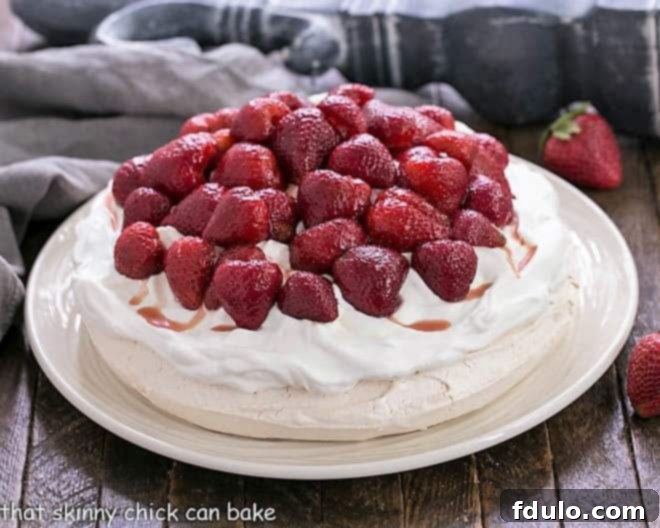
Strawberry Pavlova
20 minutes
1 hour 15 minutes
1 hour 35 minutes
8 servings
A truly stunning dessert featuring a perfectly crisp meringue base, generously topped with sweetened whipped cream and vibrant balsamic-marinated strawberries. This recipe promises a delightful contrast of textures and flavors.
Ingredients
For the Meringue Base:
- 4 large egg whites (at room temperature)
- Pinch of fine table salt
- 1 ¼ cups superfine (caster) or regular granulated sugar
- 2 teaspoons cornstarch
- 1 teaspoon white-wine vinegar or champagne vinegar
- ½ teaspoon pure vanilla extract
For the Strawberry Topping & Whipped Cream:
- 1 pound fresh strawberries, hulled and halved or quartered
- ½ teaspoon pure vanilla extract
- ½ teaspoon high-quality aged balsamic vinegar
- 1-2 teaspoons granulated sugar (adjust to taste)
- 2 cups cold heavy whipping cream (at least 36% butterfat)
- ½ cup granulated sugar (for whipped cream)
Instructions
- Prepare for Baking: Preheat your oven to 350°F (175°C). Line a large baking sheet with parchment paper. Use an 8- or 9-inch cake pan or plate to trace a circle on the parchment paper. Then, flip the parchment over so the pencil mark is on the underside (to avoid transferring lead to your meringue).
- Whip Egg Whites: In an impeccably clean, grease-free bowl of an electric mixer, combine the room-temperature egg whites and the pinch of salt. Begin beating on low speed, gradually increasing the speed to high until soft, satiny peaks begin to form.
- Add Sugar Gradually: While continuing to beat on high speed, gradually add the superfine sugar, one tablespoon at a time. Beat continuously until the meringue is very stiff, glossy, and shiny, and all the sugar has completely dissolved. Test by rubbing a small amount between your fingers; it should feel smooth, not gritty.
- Fold in Stabilizers: Gently sprinkle the cornstarch, white-wine vinegar, and vanilla extract over the meringue. Using a spatula, carefully fold these ingredients in until just combined. Be careful not to deflate the airy meringue.
- Shape and Bake Meringue: Mound the meringue mixture onto the prepared parchment paper, using the traced circle as a guide. Shape it into a disk, creating a slight indentation in the center and smoothing the sides to form a sturdy base. Place the baking sheet into the preheated oven. Immediately reduce the oven temperature to 300°F (150°C). Bake for 1 hour and 15 minutes. After baking, turn off the oven but leave the meringue inside with the door closed to cool completely for several hours, or ideally, overnight. This slow cooling prevents cracking and yields the perfect texture.
- Prepare Strawberry Topping: While the meringue cools, prepare the balsamic strawberries. In a medium mixing bowl, combine the hulled and prepared strawberries, ½ teaspoon vanilla extract, ½ teaspoon high-quality balsamic vinegar, and 1-2 teaspoons of sugar. Gently toss to coat all the berries. Cover the bowl with plastic wrap and let it sit at room temperature for at least 15 minutes, allowing the flavors to meld and the berries to macerate, releasing their delicious juices. You can leave them for up to 2 hours.
- Whip the Cream: Just before you are ready to serve, prepare the whipped cream topping. In a chilled mixing bowl (preferably using a stand mixer with a whisk attachment or a hand mixer), pour the 2 cups of cold heavy cream and ½ cup of sugar. Whip on high speed until the cream is thick enough to hold firm peaks. Be careful not to over-whip, which can cause it to become grainy.
- Assemble and Serve: Once the meringue base is completely cool, carefully invert it onto your desired serving plate and gently peel off the parchment paper. Spread the freshly whipped cream evenly over the meringue base, filling the slight indentation. Finally, spoon the prepared balsamic strawberries and their accumulated juices generously over the whipped cream. Serve your magnificent Strawberry Pavlova immediately to enjoy its perfect balance of crisp, creamy, and fruity textures.
Notes
For added stability, especially if you anticipate the dessert sitting for a while, you can add a packet of ‘Whip It’ stabilizer to your heavy cream before whipping. While not strictly necessary if serving immediately, it helps maintain the cream’s structure.
This recipe is lovingly adapted from a method by the acclaimed chef and cookbook author, Nigella Lawson, known for her indulgent and approachable recipes.
Nutrition Information:
Yield:
8
Serving Size:
1
Amount Per Serving:
Calories: 383Total Fat: 22gSaturated Fat: 14gTrans Fat: 1gUnsaturated Fat: 6gCholesterol: 67mgSodium: 61mgCarbohydrates: 45gFiber: 1gSugar: 43gProtein: 4g
HOW MUCH DID YOU LOVE THIS RECIPE?
Please leave a comment on the blog or share a photo on Pinterest
